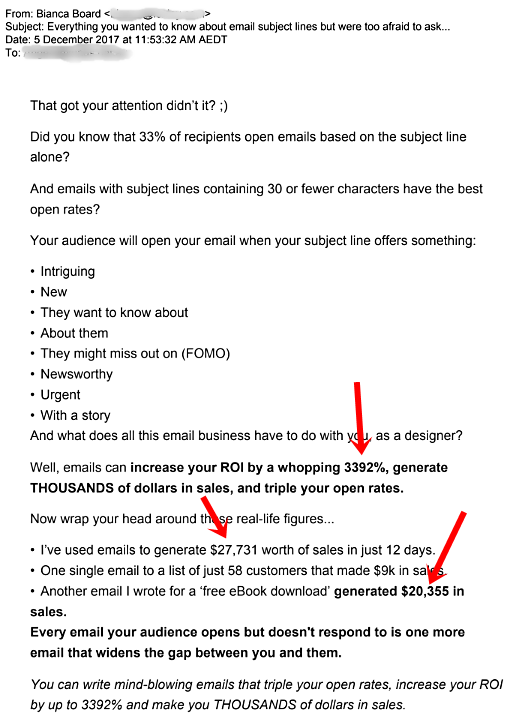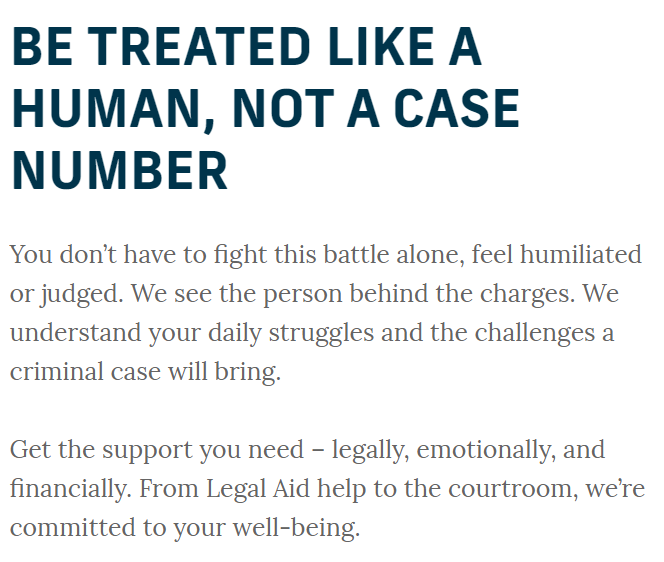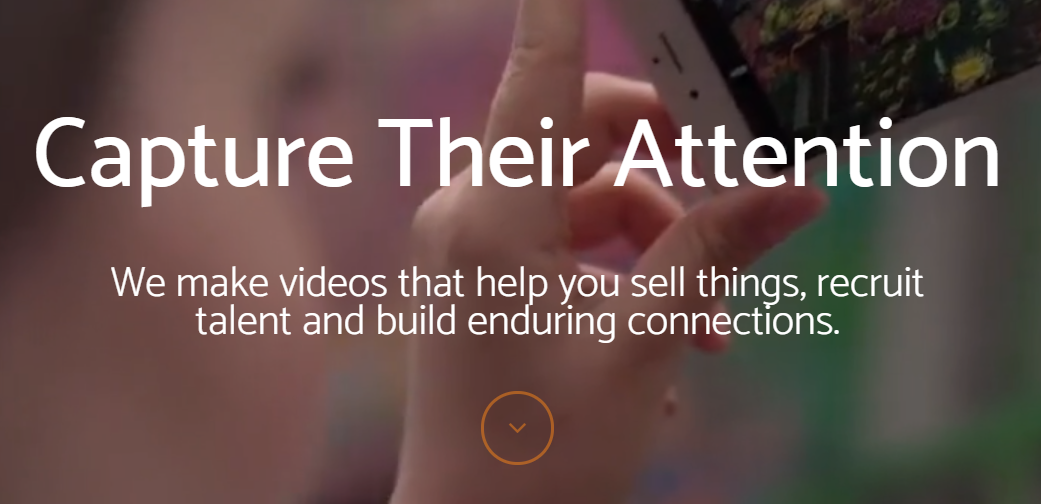Boring. Unoriginal. Embarrassing.
Do these words pop up in your head when you write your copy?
Now’s the time to put an end to it.
In this blog post, you’ll discover how to write brilliant copy that SELLS from these 21 real-life copywriting examples.
Table of Contents
These copywriting examples are paired with specific results — I reached out to the copywriters who wrote them, so you can learn how well they perform.
1. [SUPEROFFICE] CONDUCT AUDIENCE RESEARCH

Results: SuperOffice, a customer relationship management (CRM) tool, attracted 162 leads out of 9,924 users who viewed the ad on Facebook. It also drove $40,000+ in new revenue with a $6,200 ad cost.
Why It Works: It captures complete attention, as it speaks to the state of mind a prospect has when buying a CRM tool for their business.
Actionable Tip: Conduct audience research to dig deep into your target market’s struggles and goals. These insights will determine the message and angle of your copy.
2. [STRATEGYZER] APPLY THE PROBLEM-AGITATION-SOLUTION FRAMEWORK

Results: Facebook Ads copywriter Sarah Sal helped Strategyzer, a company that builds practical tools for business strategy and innovation, attract eight sales for a product that costs $499-$799 — not too shabby, considering they spent only $503.23 on this ad.
Why It Works: It’s relevant. This long-form ad copy shows an early stage company’s struggle to find a viable business model. It leads with a problem new businesses are familiar with, agitates with commonly faced obstacles, and ends with a compelling solution.
Actionable Tip: Apply the Problem-Agitation-Solution (PAS) framework when targeting a prospect who sits at the Problem Aware stage (i.e., knows they have a problem, but doesn’t know there’s a solution) in the marketing funnel.
3. [EU NATURAL] MAKE A CLEAR PROMISE AND REPEAT IT

Results: Nutritional supplement store Eu Natural got a 10.4% CTR in its brand awareness campaign.
Why It Works: Sleep like a baby? Fall asleep fast without waking up groggy? Yes, please! These powerful value propositions appeal to sleep-deprived prospects. They show what their nights and mornings look like when they take these supplements.
Actionable Tip: Make a clear promise by highlighting your USP.
4. [GROOMING HUT] OFFER AN ATTRACTIVE INCENTIVE

Results: Grooming HUT achieved 25,476 clicks out of 243,712 impressions (a CTR of 10.45%).
Why It Works: The attractive offers (40% off and free shipping) create additional value and motivate fast action.
Actionable Tip: Offer an incentive to sweeten the pot for customers (e.g., a free box for an ecommerce subscription service).
5. [FOXLEY] GET SPECIFIC WHEN SHARING NUMBERS

Results: This email is part of an email sequence written by Angela Allan for Foxley (a design masterclass by Web123). The entire email series made $3,000 in sales.
Why It Works: These real-life figures are drilled down to the exact numbers. They add authenticity.
Actionable Tip: Get specific when sharing numbers, especially in customer testimonials and case studies.
6. [SEO SLEUTH] MAKE A BOLD CLAIM AND BACK IT UP WITH COLD HARD FACTS

Results: This email subject line by SEO Sleuth had a 43.18% open rate.
Why It Works: It shares an opposite point of view.
WordPress makes a great SEO-friendly content management system, and it’s a popular choice for bloggers and businesses.
So, a bold statement like this? It goes against the grain, which compels subscribers to open the email to see just what it’s about.
Actionable Tip: Make a unique claim that contradicts popular opinion. In the remaining copy, back it up with cold hard facts (e.g., data, case studies).
7. [THE SCRIBESMITH] USE THE WORD “I”

Results: This email, written by Eman Zabi of The Scribesmith, was for an in-person workshop hosted by a business consultant. It had a conversion rate of 10% (242 replied to this email and purchased tickets).
Why It Works: The conversational and personal tone feels as though the business consultant is reaching out to each subscriber individually.
Actionable Tip: Use the word “I” to create a personal conversation. Do this only when the business is largely based on your personal brand.
If not, lead with “You.”More on this in #18 (Tidio).
8. [GEMMA BONHAM CARTER] TEASE PROSPECTS WITH AN EXCLUSIVE LOOK

Results: Online business coach Gemma Bonham Carter consistently hits a 70% conversion rate on her landing page.
Why It Works: The four pictures work as an excerpt of the free expert guide — they offer a sneak peek and stir up desire.
Actionable Tip: Tease prospects with an exclusive look at what your lead magnet looks like. If it’s an ebook, take a screenshot of the first few pages and insert them in iPad frames to make them look polished. You can do this easily on Canva and other similar tools.
9. [GROWBOTS] INCREASE VISIBILITY OF IMPORTANT ELEMENTS

Results: Outbound sales platform Growbots currently converts 35.63% of its prospects on its ebook landing page.
Why It Works: The neon green call-to-action (CTA) button against the white background is impossible to miss. Notice how it draws your eyes in?
Actionable Tip: Increase the visibility of the important elements in your copy (e.g., increase font size and bold important words, capitalize CTA text).
10. [MATTHEW HUSSEY] USE YOUR CUSTOMERS’ WORDS

Results: Copywriter Angela Allan rewrote the copy for dating coach Matthew Hussey’s landing page and increased the coaching program sign-ups by 44%.
Why It Works: The headline matches the prospect’s state of mind — it confirms they’re in the right place.
Actionable Tip: Go through the transcripts of your customer interviews, testimonials, or support messages and use their words! Pick a question or phrase that keeps popping up and turn it into a headline.
11. [NICOLA MOORS] INJECT YOUR UNIQUE PERSONALITY

Results: Copywriter Nicola Moors enjoyed a 43% conversion rate on her lead magnet landing page.
Why It Works: The witty copy matches the personality of Nicola’s prospects. It resonates with them and prompts them to opt in to her list.
Actionable Tip: Inject your unique personality to attract and connect with an ideal audience.
12. [BROSIX] ADD LOGOS OF EXISTING CLIENTS

Results: Messaging platform Brosix enjoys a 43% conversion rate on its landing page.
Why It Works: Client logos tell prospects that these big companies approve of Brosix’s products. These logos build confidence, encouraging them to act.
Actionable Tip: Add logos of existing clients. Work with many clients? Display the exact number in the subhead (e.g., “215 companies trust [Your Company]!”).
13. [HOPPIER] FEATURE TESTIMONIALS FROM YOUR HERO CUSTOMERS

Results: Hoppier, a company that offers healthy snacks, supplies, and consumables to offices, achieved a 4.56% conversion rate on its homepage.
Why It Works: The testimonials by satisfied customers resemble Hoppier’s target market.
Actionable Tip: Put your hero customers in the spotlight on the peer testimonials section of your website.
14. [STUART MILLER] RELIEVE (OR REMOVE) A PROSPECT’S PAIN

Results: Copywriter Rachael Bueckert rewrote the homepage for Stuart Miller, a law practice in London. Together with Joel Klettke (Supervisor and conversion rate optimization copywriter) and Danny Richman (SEO consultant), the team achieves a 15.3% conversion rate.
A big improvement, as the website previously sat at 2%.
Why It Works: This homepage copy reminds prospects that they are more than just a case number. It strikes an emotional chord, as it offers hope and comfort.
Actionable Tip: Remove — or at the very least, relieve — your prospect’s pain with emotional copy. One way to do this is to flip the focus to a position emotion, like what Rachael has done here:
You feel alone, humiliated, or judged = You don’t have to fight this battle alone, feel humiliated, or judged.
15. [MICHAL EISIKOWITZ] INCLUDE A SECTION OF YOUR CUSTOMER PERSONAS

Results: Copywriter Michal Eisikowitz consistently books new projects three months in advance.
Why It Works: It distinctly shows who Michal works with and the struggles they go through in their line of work. Right off the bat, prospects know if they’d be a good fit.
Actionable Tip: Include a section of your customer personas if you have multiple customer segments. Clearly show the role or department they’re in, paying special attention to the words they use to describe themselves.
This approach saves you time from weeding out unfit clients and improves your website’s user experience.
Work with just one type of client? Opt for a “Fit for” section (i.e., We’re a fit if VS. We’re NOT a fit if).
16. [FOTURA] PLACE “CLICK BOOSTERS” NEAR YOUR CTA BUTTON

Results: Fotura, a website that teaches beginners how to take product photos, scores a 29% conversion rate on its homepage.
Why It Works: The click boosters “Free sign-up” and “No credit card required” tell users that signing up for an account is quick and easy.
Actionable Tip: Identify the main risk that stops prospects from buying or signing up, and come up with a risk antidote that combats it.
This risk antidote acts as your click booster. Place it near your CTA button to lower the barriers to taking action.
If you sell expensive furniture, your prospect probably has a fear of losing money. With this, you can reverse the risk with a click booster (e.g., a 90-day money back guarantee) and include it next to the CTA button.
17. [SIGNATURE VIDEO GROUP] STRESS BENEFITS

Results: Video content agency Signature Video Group (SVG) currently sees a 6-8% conversion rate on its homepage.
Why It Works: “Sell things,” “recruit talent,” and “build enduring connections” explicitly show the attractive benefits clients get.
Actionable Tip: Stress benefits and connect them with your prospects’ goals. Zoom in on what it looks like on an emotional level.
For a content marketing agency, it’s not well-written blog posts. It’s ranking page 1 on Google and attracting high-quality leads.
For a freelance virtual assistant who works with entrepreneurs, it’s not scheduling and planning appointments. It’s saving 20 hours a week and skyrocketing productivity.
18. [TIDIO] ADD A “YOU” SPIN

Results: Tidio, a SaaS startup that sells modern communication tools to SMBs, boasted a 21.4% conversion rate on its homepage.
Why It Works: The second-person point of view (POV) puts prospects in the center of the action and reinforces your product or service’s benefits.
Actionable Tip: Add a “you” spin in your copy.
All-In-One Invoicing & Accounting Tool = You can now send invoices and track expenses in one place
Powerful SEO Services = You’re finally on the first page of Google
Reliable Web Design Agency = You’re ready to leave competition in the digital dust
The second-person POV isn’t the only way to increase the conversion rate. Another way to approach this is to…
19. [DOCUMENT360] USE VERBS

Results: This Google Ad from Document360 (created by Hey Digital) hit a 5.19% conversion rate.
Why It Works: These action-driven verbs hook prospects, helping them picture what their lives look like after using this knowledge base tool.
Actionable Tip: Mix your copy with verbs; it’s as simple as that.
We just launched an online cap maker = Personalize your cap with your own unique style
Top rankings for our SEO services = Rank page 1 on Google
Customizable gym workouts that meet personal fitness goals = Customize your gym workouts. Meet your personal fitness goals.
20. [PROCUREMENT FLOW] REPLACE WORDS WITH NUMBERS

Results: Collaborative teamwork software ProcurementFlow hired Hey Digital to create a Google Ad, resulting in a conversion rate of 7.14%.
Why It Works: “#1” and “14-Day” draw eyes into the copy, as numbers attract fixations.[*]
Actionable Tip: Replace words with numbers (e.g., one thousand dollars = $1,000, fifty percent = 50%).
21. [MYADVO.IN] REPEAT AND REPHRASE YOUR CORE MESSAGE

Results: Legal technology platform MyAdvo enjoyed a conversion rate of 30.95% in this real estate law ad.
Why It Works: Repetition stresses important points and makes them more memorable in your copy. “File a complaint in RERA” in the headline and “File a case in RERA against the builders” in the ad description reinforce the value proposition and strengthen the overall message of the ad.[*]
Actionable Tip: Repeat and rephrase your core message throughout the rest of the copy to reinforce it.
Write Bland Brilliant Copy That SELLS
Great copywriting requires more than persuasive words.
It also involves powerful images, error-free audience research, and intuitive design experience.
Ready to add a new spin on your copy and start winning sales?
To recap, here’s what you’ve learned:
Conduct audience research to dig deep into the struggles and goals of your target market.
Apply the Problem-Agitation-Solution framework when targeting a pain-aware prospect.
Make a clear promise (and repeat it) by highlighting your USP.
Offer an attractive incentive to sweeten the pot for customers.
Get specific when sharing numbers in customer testimonials and case studies.
Make a bold claim and back it up with cold hard facts (e.g., data) in the remaining of your copy.
Use the word “I” if your business is largely based on your personal brand.
Tease prospects with an exclusive look at how your lead magnet looks like to provoke action.
Increase visibility of important elements (e.g., use a striking color, increase font size).
Use your customers’ words — go through the transcripts of the interviews, pick a common question or phrase, and turn it into a headline.
- Inject your unique personality to attract and connect with an ideal audience.
Add logos of existing clients.
Feature testimonials from your hero customers (i.e., customers who make up your target market).
Relive (or remove) prospect’s pain with emotional copy.
Include a section of your customer personas that clearly shows the role or department they’re in and the words they use to describe themselves.
Place “click boosters” near your CTA button to lower the barriers of taking action.
Stress benefits — zoom in on what they look like on an emotional level.
Add a “you” spin in your copy to put prospects in the center of the action.
Use verbs.
Replace words with numbers.
Repeat and rephrase your core message throughout the rest of the copy to reinforce it.
Let’s go get those new customers!
Add A Comment
VIEW THE COMMENTS